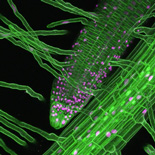Timelapse of Dancing Plant Root Wins 2017 Nikon Small World in Motion Competition

Posted on September 21, 2017
Nikon Instruments Inc. today unveiled the winners of the seventh annual Nikon Small World in Motion Photomicrography Competition, awarding First Place to Daniel von Wangenheim from the Institute of Science and Technology Austria for his time lapse video following the root tip of Arabidopsis thaliana (also known as the Thale cress). The video reflects a time lapse of 17 hours and approximately 4mm of growth. Von Wangenheim and his colleagues are studying how plants perceive and respond to gravity.
“Once we have a better understanding of the behavior of plant roots and its underlying mechanisms, we can help them grow deeper into the soil to reach water or defy gravity in upper areas of the soil to adjust their root branching angle to areas with richer nutrients,” said von Wangenheim. “One step further, this could finally help to successfully grow plants under microgravity conditions in outer space to provide food for astronauts in long-lasting missions.”
To film the growing root, von Wangenheim and his colleagues, Robert Hauschild, Matyáš Fendrych, Eva Benkova and Jiří Friml, turned a confocal microscope on its side to provide an upright position. They then placed the plant on a rotation stage, with the root between a coverslip and a block of gel and the leaves exposed to the air. They also implemented a lighting system that simulated ideal growing conditions and a day-night rhythm. As they rotated the plant, they observed how the root would bend downwards each time, sensing gravity.
“The aesthetic craftsmanship and the scientific component of this winning video are truly remarkable. Von Wangenheim and his team have really captured the essence of Nikon Small World in Motion,” said Eric Flem, Communications Manager, Nikon Instruments. “As imaging technology continues to advance, it’s videos like this and the rest of our winners that help bring the intricacies of scientific research to the public.”
While the subject of the winning video succumbs to gravity, this year’s second place video is about defying it. To capture a time lapse of a sweating fingertip, Tsutomu Tomita of Shiki, Japan, created tension amongst the subjects by showing them a video of daredevils climbing to the top of a skyscraper. Sweating is a common part of daily life, but being able to see it at a microscopic level is equally enlightening and cringe-worthy.
This year’s third place winner, Satoshi Nishimura of Shimotsuke-shi, Japan, captures another fascinating human body phenomenon with his video of leukocyte accumulations and platelet aggregations as they help heal an injury. While this video depicts the process occurring in a mouse, it provides a rare look at how the body reacts to a puncture wound and begins the healing process.
“I like to show people the beauty of our research, and this competition is a great platform to give insight into what we and other scientists are doing. Sharing this insight beyond the scientific community is very important and can also help inspire young people to explore science,” said von Wangenheim.
The 2017 judging panel includes:
• Dr. Bob Goldman: Chair, Department of Cell and Molecular Biology, Northwestern University Feinberg School of Medicine.
• Robert Krulwich: Radio and television journalist who currently serves as a science correspondent for NPR and is a co-host of the award-winning WNYC program Radiolab.
• Dave Mosher: Science and technology correspondent at Business Insider with more than a decade of digital, print, video, and photo journalism experience.
• Dr. Clare Waterman: National Institute of Health (NIH) Distinguished Investigator at the Laboratory of Cell and Tissue Morphodynamics.
• Eric Clark (Moderator): Research Coordinator and Applications Developer at the National High Magnetic Field Laboratory at Florida State University.
For additional information, please visit www.nikonsmallworld.com, or follow the conversation on Facebook, Twitter @NikonSmallWorld and Instagram @NikonInstruments.
